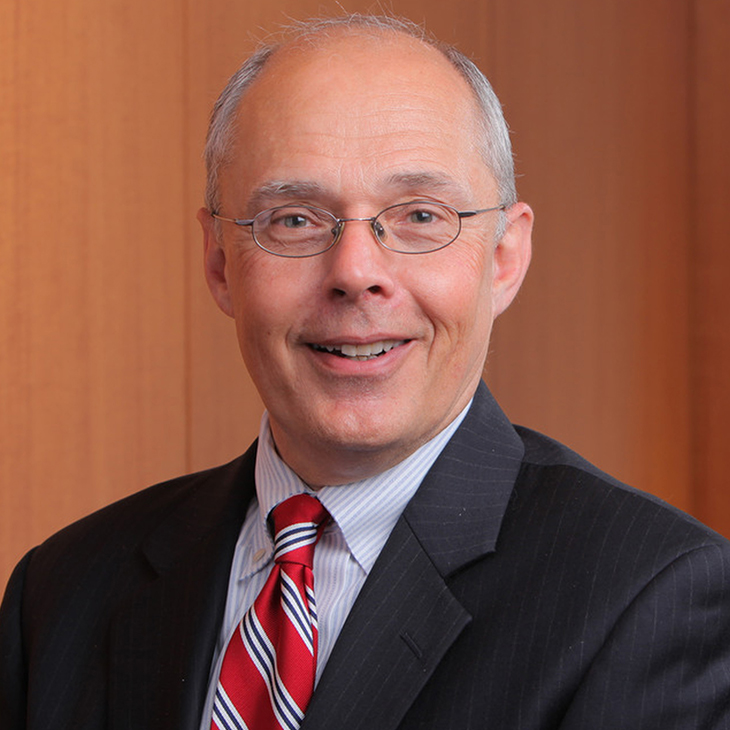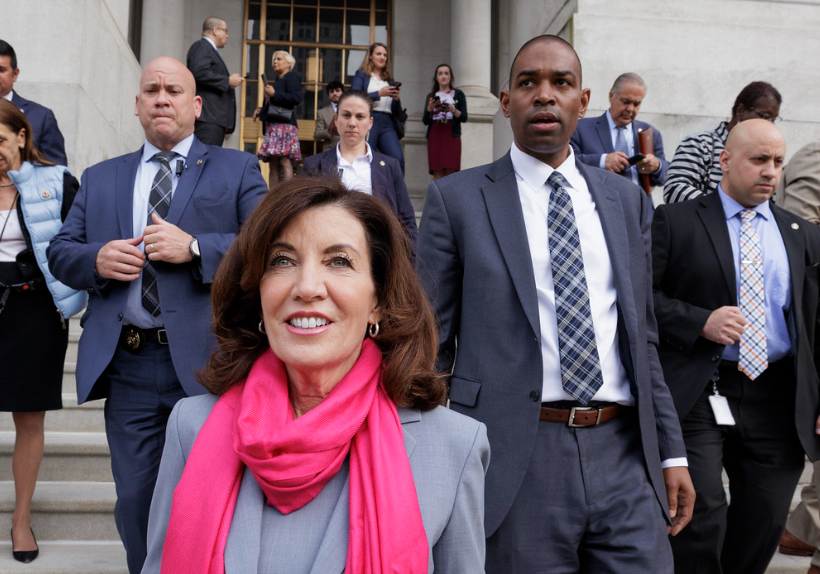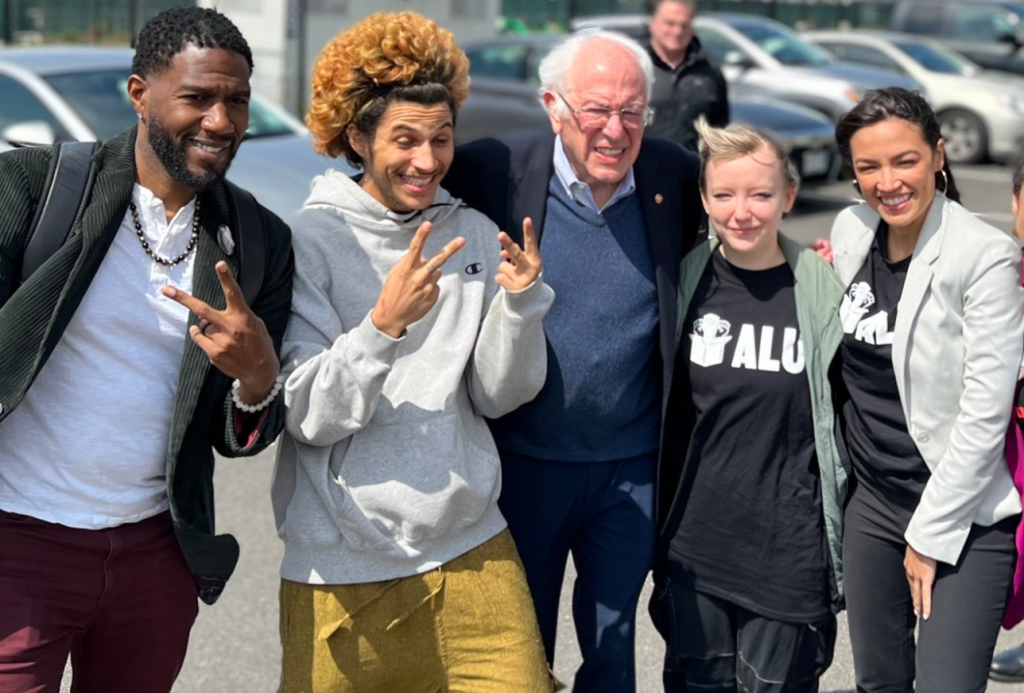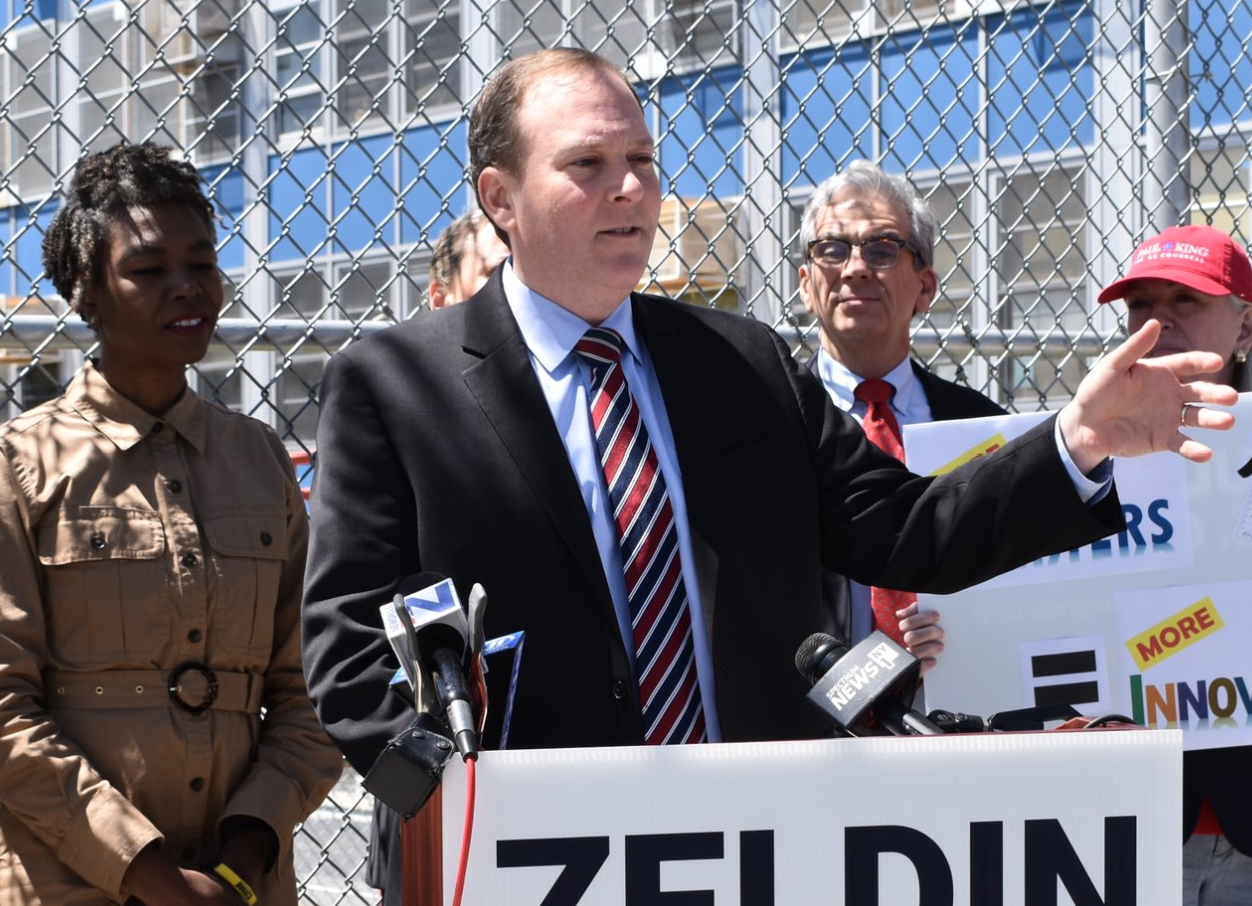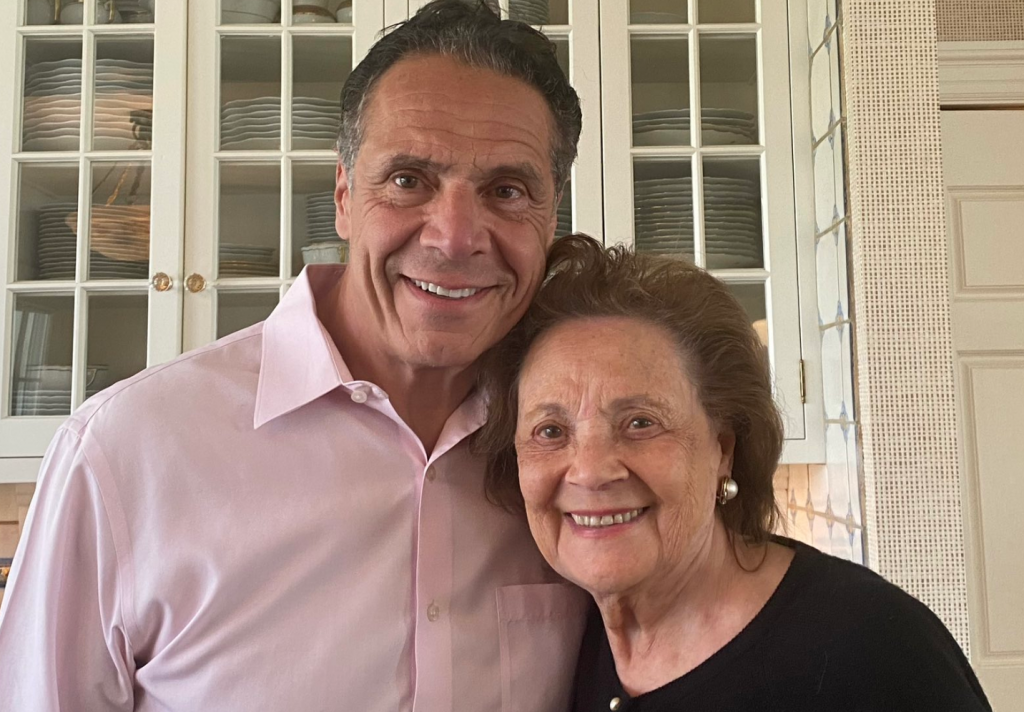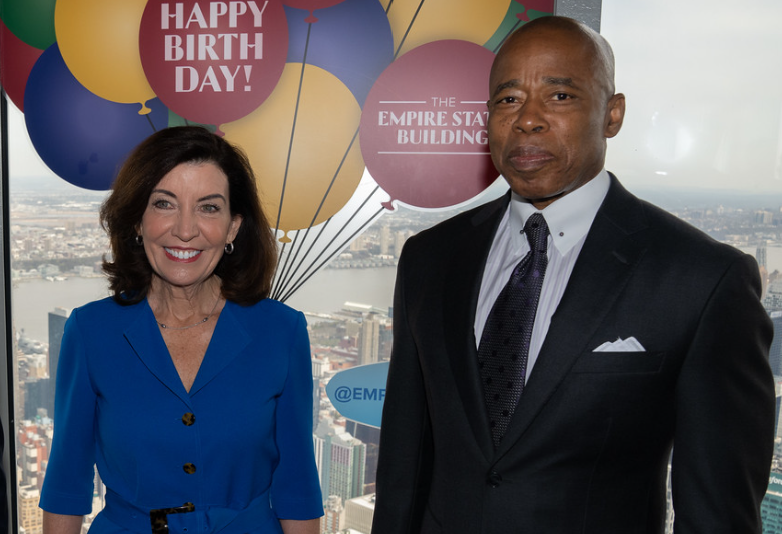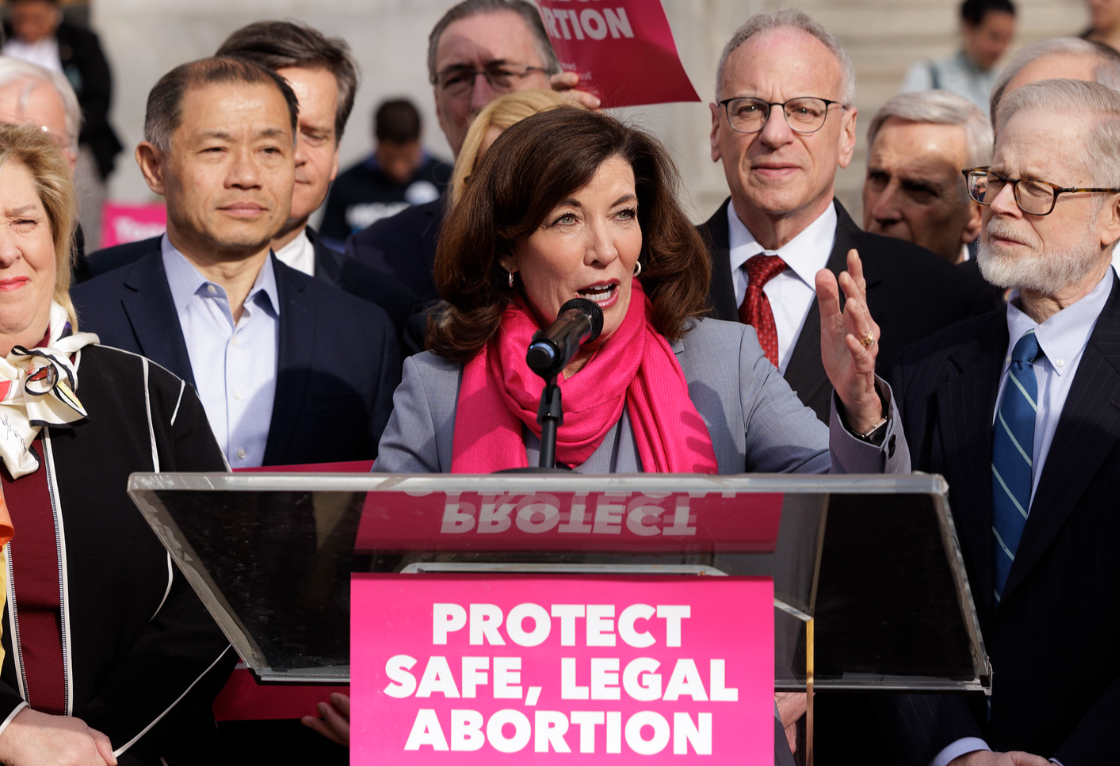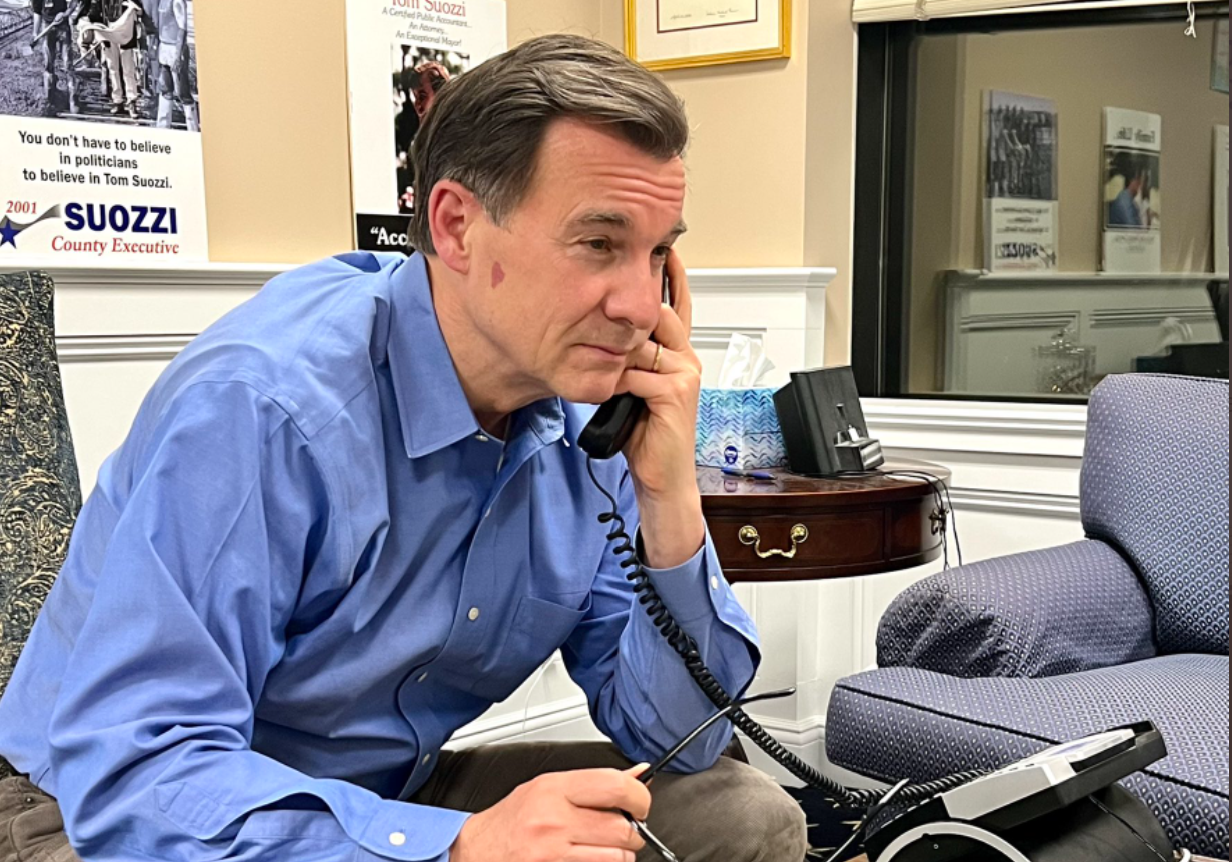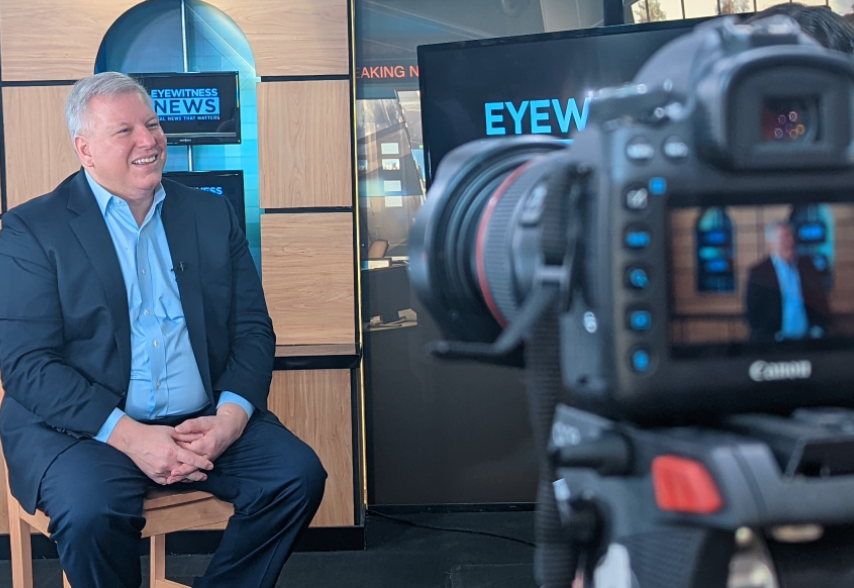Gauging the Gubernatorial Gauntlet II: Piercing a Panoply of Optical Illusions.
Back in late October I wrote a piece for Empire Report, entitled Gauging the Gubernatorial Gauntlet, which tried to provide a handicapper’s guide to the applied math of NYS politics. I had finished my outline for this follow up piece, which is designed to go to the next step of piercing what has become a rather full panoply of optical illusions surrounding this gubernatorial race. The morning I first began writing this piece, the political equivalent of an asteroid struck in the form of the federal indictment of Lt. Governor Brian Benjamin. I quickly decided to put this column aside for a few weeks, in order to see how the race would sort itself out.
It was simply too soon back then to immediately assess with any informed precision, how Benjamin’s indictment would ultimately impact the race. Conventional wisdom, underscored by the musings of Governor Hochul’s opponents, both Democratic and Republican, seemed to be lurching towards concluding that this indictment had grievously wounded Governor Hochul’s prospects for winning a full term.
That assessment could not be dismissed, but it also discounted the very real weaknesses plaguing all her opponents, both in the primary and the general election . Now that Hochul defied the early conventional wisdom and succeeded in not just appointing a new Lieutenant Governor in Antonio Delgado (which secured mostly favorable reactions within the Democratic Party), but also secured via a change in state law, getting Delgado on the ballot for the Democratic Primary, the Benjamin indictment now seems more of an embarrassment for Hochul and her campaign, than a grievous blow to her re-election prospects.
Consequently, when you step back, here is what I would posit as a realistic assessment of where this race stands heading towards Memorial Day. First, Hochul was never as strong as she looked on January 18th (the day after DeBlasio decided not to run in the primary and the morning that a very favorable Siena poll was released and her blockbuster campaign finance report showing her not only crossing the $20 million threshold, but dwarfing the fundraising hauls of all her challengers, not to mention receiving a great deal of positive reaction to the Executive Budget Hochul presented that afternoon), nor as weak as she appeared on April 18th (in the wake of her judgment being questioned on the selection of Benjamin as LG and the criticism of how the Democrats had handled everything from the Bills stadium financing to the grousing from both extremes on what was done in the Budget on bail reform and new public polling revealing that NYS’ electorate was in a very sour mood). Conventional wisdom, in my view, was too rosy on Hochul in late January and far too gloomy in late April.
Second, to be elected Governor in New York State, requires that a candidate be able to construct a multi-racial/ethnic as well and cross regional political coalition, which holds the vital center of the state’s center left ideological fulcrum point. That formula is particularly critical for a Democratic candidate to master, given the diversity of their party and the state. Therefore, when factoring all of that in, Hochul remains the only candidate in either party, currently poised to meet that test. Neither of her primary opponents seem to be within striking distance of beating her in the primary, though I think the public polling data is dramatically undercounting where Jumaane Williams will finish. If current trends continue apace, I suspect that Williams will garner at least at a quarter but less than a third of the primary vote, while Suozzi is likely stuck in the low to mid-teens, which is exactly where he finished against Spitzer in 2006. The real question will be does Hochul finish at closer to 50% or 60% of the vote in winning this primary.
On the Republican side, the primary is wide open. Andrew Giuliani remains far more than the mere irritant that the Zeldin campaign is treating him as, while the jury is out on whether Harry Wilson’s huge TV ad barrage is connecting with the Republican’s primary electorate. If the meager polling on the Republican primary is accurate, Astorino is undercutting both Giuliani and Zeldin in the downstate Suburbs. In the end, the winner of this Republican primary will be whoever outworks the others in carrying the diverse expanse of Upstate where at least 60-62% of the GOP primary vote is likely to be cast. Meanwhile, whether Hochul wins in November, by closer to 5% or cracks 15% in terms of victory margin, or blows her chances down the stretch, will be a function of events and how the candidates’ campaigns, in effect master or are conquered by those events in the general election.
Third, in terms of Andrew Cuomo, unless the public polling data is completely erroneous, we are wasting our time waiting for Godot in terms of his prospects for actually running for Governor this year. Cuomo’s negatives among key groups are so high, that he could win neither a Democratic primary (which he astutely passed on entering), nor a general election, if he petitioned to become a third party candidate. So if Andrew Cuomo is the same shrewd and supple political strategist we have all known for over 40 years, he will not run this year, just to lose.
To those who expect him to run he would have to bet his frayed legacy on a wish that for voters he is like Napoleon on Elba, one well timed cavalry charge from being able to defeat Wellington at Waterloo, rather than where the polling data seems to put him, on the political equivalent of St. Helena, a point of no return. The Andrew Cuomo we have all known for so long, is a careful, precise and astute political strategist, who has always been risk averse. To expect Andrew Cuomo to gamble his attempt at a return from disgrace to relevance in the public square, on such long odds, would be contrary to his longstanding meticulous approach to politics. I may be completely misreading this, but I do not think Cuomo will enter this gubernatorial contest, for if he does, he will almost certainly lose.
To persuade you that I am correct in those three assessments, we will need to pierce the rather full constellation of optical illusions surrounding this gubernatorial race. There are at least four such illusions worth charting.
The first optical illusion that needs piercing, is the contention that it was Hochul’s political needs alone, which necessitated modifications in bail reform accompanying the Budget. In fact, the entire Democratic ticket from the statewide candidates down through the lowest local races, needed political armor on crime to protect them this Fall, particularly in the key state legislative races in marginal districts outside of NYC. Consequently, the Legislature may have grumbled about passing the compromise around bail reform with this year’s budget (especially among the pure progressive flanks in both majority conferences), but they ultimately did so to protect their incumbents in swing districts (the districts that currently provide them with their super majorities) as well as the political interests of Schumer, DiNapoli, James and Hochul who very much want to maximize their statewide victory margins.
The best way to glimpse the real danger in the woods for Democratic incumbents from the top to the bottom of the Democratic ticket, lies in accurately charting the polling data. Let’s use the Siena polling data as a benchmark. In February, Siena’s right track /wrong track question for NYS measured 41% right track and 45 % wrong track, but by April those numbers had dropped to 36-52% with right track way behind wrong track. In recent years, New Yorkers had been more optimistic on this question for NYS than the nation being on the right track. By April that difference had significantly shrunk (the right track/wrong track for the nation among NYS voters was at 34 right track to 57% wrong track, in both the mid-February and late April Siena polling data). The bottom line is crystal clear, NYS voters are in a decidedly sour mood and that is not a healthy sign when one party is in control of all statewide offices and both houses of the Legislature, as the Democrats are today.
The February data in the Siena poll also showed that the historic political wolf at the door had returned for Democrats: when crime and inflation were rising simultaneously Democratic prospects are in jeopardy (e.g., 1966 and 1980). In the February Siena poll, 63% of New York State voters felt that inflation was having a “very serious” effect on the economy. That very serious rating registered at 83% among Republicans, 68% among those 35-54 in age, 67% among Catholics, 58% with both Independents and moderates, 55% among Jewish voters and 63% in the Suburbs as well as 68% Upstate, 64% among Whites and Latinos, while at 57% among Blacks.
That February Siena poll also showed that by 65-27% NYS voters wanted to give judges more discretion to keep dangerous criminals off the street. The cross tabs are very revealing among those who wanted to give judges more discretion in setting bail: 88% of Republicans, 80% conservatives, 61% of Independents, 56% of Democrats, 69% of moderates, 77% of Catholics, 67% of Jewish voters, 67% both in the Suburbs and Upstate, 73% among White voters and 72% of those voters 55 in age and older (the bedrock voters in midterm elections), but was also narrowly approved by 44-40% among Black and 48-41% among Latino voters.
Nor did the numbers on crime get better for Democrats on bail reform in the Siena poll released on March 28th. That polling showed that in the Siena data from April 2019 (just before bail reform was first passed) NYS voters thought the original bail reform proposal was good rather than bad for New York by 55-38%. However, by January 2020, support for the bail reform enacted had gone underwater with only 37% saying it was good for New York and 49% saying it was bad for the state. By the time the Siena poll was released on March 28 of 2022, despite the enactment of modifications in bail reform in the interim period, support had dropped to 30% who thought bail reform was good, versus 56% thinking it was bad for New York (a complete reverse of Siena’s 2019 polling).
In this end of March Siena poll, the percentage of New York voters who wanted judges to have more discretion in setting bail jumped to 82 in support to only 11% opposed (87% in the Suburbs, 81% upstate, 79% in NYC, but also 79% among Democrats, 72% among Blacks and 82% among Latinos, despite 56% also feeling that providing that more discretion to judges on bail, could result in poor people and people of color being discriminated against). It should have been clear to any objective read of the politics that the lightning rod quotient of bail reform was accelerating not receding and long term the best way to save bail reform was to add more judicial discretion.
When you boil all that down here is what the political minefield that was facing Democrats as Winter turned towards Spring this year. The twin pillars of political danger– rising inflation and rising crime– were poised to act as wedge issues hurting Democratic candidates in the general election (i.e., dividing Democrats and pushing Independents towards the open arms of the Republicans). The model for a swing voter in this year’s general election therefore becomes White Catholic women, with a college education, living in a suburban town (Upstate as well as Downstate). The candidates who win the majority of those voters will win their races. Keep in mind that while White Catholics are about a third of the state’s electorate, they are usually about half of swing voters general elections, and married White Catholic women are usually the pivot point for the larger constellation of swing voters.
Democrats here in NYS can do almost nothing to impact inflation, which has its roots in national and international economic trends, but they could impact the perceptions on the Democrats’ approach to fighting crime. Perceptions were exacerbated by the approach of Alvin Bragg, the newly elected DA in Manhattan, whose approach to announcing new prosecutorial guidelines in his first week in office gave Republicans a credible rallying cry that his approach was nullification of the criminal code, in effect putting a coda on the narrative. In short, it is no accident that Bragg became a major player in the TV ads for Zeldin and Wilson on the Republican side and in the huge ad buy for the IE supporting Suozzi.
Nor could this debate over bail reform be won by Democrats providing statistical analyses showing that bail reform was a small ingredient in the mix of factors leading to the crime surge not just in NYC but in the urban centers Upstate. The narrative on bail reform, had not only been set in the 2020 campaign (when the Democrats had lost two State Senate seats on this issue– one in Suffolk and one in the mid- Hudson) while seeing their victory margins shrunk across LI and the northern Suburbs, but also in 2021 when bail reform was the battering ram issue that cost the Democrats both DA’s races on LI and the Nassau County Executive’s race.
Yet, the danger lurking this year for Democrats on bail reform went even deeper. Bail reform for far too many voters including voters of color (especially Hispanic and Asian voters in NYC) had become a lightning rod for a suspicion that a signal had been sent by Democratic DA’s and the police chiefs in Democratic controlled cities that a rise in crime would be tolerated. The lingering rhetoric of some Democrats advocating defunding the police had been stoked by Republicans all too successfully at all levels of the public debate on crime. That narrative may not be fair and much of the stoking of the kindling underneath that narrative may have been demagogic, but it had proven effective for Republicans in multiple races nationally as well as in NYS, since 2020.
As an aside, Democrats need to stop conducting campaigns as if they were determined by lists annotated by position papers and begin to create persuasive narratives for voters to quickly grasp.
It was into that cauldron that Governor Hochul stepped in and stirred the pot pushing the Legislature to enact further reform bail, before the Republicans built a wave for repeal, that even Democrats like Tom Suozzi were nurturing, despite the clear results in the polling data that voters supported the central thrust of bail reform, not allowing poverty and race to lock people up before conviction, but they wanted judicial discretion as a safety valve to protect public safety. The post- Budget Siena poll released on April 25th, revealed that voters supported the compromise Hochul brokered providing more discretion for judges on setting bail by 67-14% (supported by 72% of Democrats, 65% of Republicans, 59% of independents, 72% in NYC, 66% in the Suburbs, and 64% Upstate, 76% of those 55 and older, 75% of Catholics, 74% of Jewish voters and 62% of Latinos, 58% of Blacks and 69% of White voters).
In reality, this bail reform compromise pushed by Hochul, fully satisfied no one. But precisely because bail reform is a lightning rod for the larger public concern on crime, what this compromise achieved for Democrats was a breaking of the fever around bail reform. The ultimate determination on the potency of crime as a motivating issue for voters this Fall, will derive from voters perceptions coming out of Labor Day, on the rise in crime. Thus, Hochul’s compromise with the Legislature, in effect bought the Democrats time.
If the perception is that crime is continuing to rise going into the Fall, that will hurt Democrats up and down the ticket. If, however, the perception come the Fall is that the rise crime is receding then the fear of crime might just dissipate as a wedge issue. Keep in mind that in terms of the crime rate, what happens on crime in NYC drives public opinion on crime from Montauk at the tip of LI to Millbrook in the Hudson Valley, given the huge Greater New York media market. Especially given the Court of Appeals rejection of the reapportionment lines for the Congress and State Senate, which means the lines Democrats run on will almost assuredly be less favorable, down ballot Democrats owe Hochul a debt of gratitude for breaking the political fever on bail reform.
In the final analysis, the seminal issue is not bail reform, it is the fear emanating from the rising crime folks see on the subways of NYC, in their communities and in the media coverage. It is neither a mirage, nor is it a concern only of older White voters, instead it is a key concern of older Black as well as Hispanic and Asian voters.
Hispanic voters and Asian voters tend to march separately towards and away from candidates, but they often wind up traveling to same destination in terms of their votes. As the aggregate of Hispanic and Asian voters grows from its current share of 25-30% of the total vote in NYC, towards a 33-35% of the city’s vote by the end of this decade and being on the cusp of reaching a 40 % share by 2035, if the Democrats’ start losing support among these Hispanic and Asian voters, on issues like crime, it will have dramatic impact going forward on both NYC and NYS politics. If the Democrats are not careful, they may rue ignoring that Curtis Sliwa not Eric Adams carried Ron Kim’s Queens Assembly District in the November 2021 mayoral election in NYC. Creating a narrative which melds public safety with criminal justice reform should be job one for any successful Democratic strategy going forward.
Alternatively, if the GOP can consistently garner 40 % or more of the vote in the Latino and Asian communities as Pataki and Bloomberg were able to do in 2001 and 2002, they will be on the cusp of a political rebirth. Consequently, to ignore that the Democratic majorities in the Legislature did not have a significant political interest in passing this year’s further modification of the bail laws is to deny political reality.
The second optical illusion is smugly believing that we know now for a certainty, which issues will have salience in the gubernatorial campaign this Fall. We know that rising inflation and crime are likely to be front and center for voters, but we don’t know if those concerns will be as virulent in the Fall as they have been this Spring. Democrats should prepare for the worst case scenario on each issue, while hoping for some amelioration in the concerns of voters over crime and inflation. But now the prospect of Roe v. Wade almost certainly being overturned this Summer by the Supreme Court, could become an issue that motivates this state’s clear and consistent pro Roe v. Wade majority that has long existed but has also grown quite complacent.
It is no accident that since abortion became a controversial issue, no Governor has been elected who did not make it crystal clear that they were pro-choice (that was as true for Rockefeller and Pataki as it was for Carey, both Cuomos and Spitzer). Lurking in the polling data has long been the plain fact that younger voters, particularly single women, could not quite come to believe that Roe v. Wade would not be the law of the land. That complacency is about to be replaced by a mix of anger and fear among younger supporters of Roe v. Wade, especially younger women. Meanwhile, we do not yet know how significant the Roe v. Wade issue will be in terms of mobilizing voters along both sides of the political barricades on abortion.
In addition, other issues could crop up over the Summer and into the Fall, becoming major concerns for voters, that we don’t yet glimpse. Will a major climate event hit NYS in August or September, a la superstorms Irene and Sandy? That would hurt Republicans who could be portrayed as denying the importance of combating climate change. Could political violence from either the extreme right or the hard left rear its ugly head? Let’s hope not, but if political violence were to tragically occur, then whichever partisan side is aligned with the motivations of the provocateurs of that violence, would likely be hurt in the eyes of voters. Let’s all pray that no racial based violence tied to hate crimes hit us like a political plague, whether lodged in a George Floyd type tragedy or anti-Asian or anti -Semitic hate crimes. But political repercussions would attend any and all such senseless violence.
Will we get a spike in Covid in the early Fall and if so, will it politically motivate the angry anti-mask minority or the more passive pro-vaccination majority in NYS? Or will Russia’s needless war in Ukraine and its repercussions take hold of the public imagination and benefit one party or the other? Could the January 6th Congressional Committee’s investigation’s public hearings galvanize opposition to Trump among the broad mass of New York’s anti- Trump voters, hurting Republicans like Zeldin or Giuliani should they win the Republican primary? Or will those hearings fall like a tree in an empty forest with no impact on voting behavior? The question marks are long and the answers to these questions mighty short.
We simply do not know if or how these potential issues would impact the gubernatorial race in this year’s general election. Do I expect all of these issues to become salient with voters by Fall, certainly not. But some of them might resonate with voters and therefore help or hurt either the Democrats or the Republicans. Not to mention that we could see countervailing partisan trends cross tugging voters attending these late breaking issue concerns. The bottom line is clear, the salience of issues lies in the eyes, hearts and minds of voters. Voters will decide what issues they will focus on, before casting their votes. The politicians and certainly the pundits can opine, but voters will decide the issues and concerns that will drive them towards or away from casting ballots and which gubernatorial candidates will benefit and lose from those choices.
The skill of the campaigns in how they play off the issues and themes upon which voters place a priority will be a critical in terms of who wins the general election, both in terms of going on offense or playing effective defense. The public’s sour mood in our state raises Republican hopes, but the Democratic advantages in terms of registration and political demographics leaves them as clear favorites (especially if the Republican primary leaves more scars than the Democratic primary), with the ultimate margin of victory very much in doubt.
Finally, issues and themes tend to go into the Summer months as the political equivalent of soft clay, emerging out of Labor Day as if put through a kiln, hardening perceptions into clear outlooks by and motivations for voters. We would be wise to study this Summer’s kiln effect for what emerges in the Fall, rather than presuming today that we know what hardens into pottery from soft clay. Not to mention that some issues pop out of nowhere as the proverbial October surprises. Smart campaigns are right to prepare for what they don’t know, rather than presuming that they know everything they need to know to win the race they are in. It is an optical illusion to presume that surprises will not occur and there is no way to predict how the candidates and their campaigns will handle the stress of these duress laced surprises.
The third optical illusion is seeing through the combination of sparse and inaccurate public polling, not to mention the campaign polling leaked to the media, in both party’s primaries . We have already had a fair amount of such polling gubernatorial campaign. In my first piece in this gubernatorial gauntlet series, back in October, I went into great detail on the distinct regional, ideological, gender, racial, ethnic and religious templates in both party’s primaries. Not to mention that because who votes in primaries varies far greater than in general elections, makes it much tougher for pollsters to correctly crack the code on crafting an accurate polling sample. For example, statewide primary turnouts among Democrats can be as low as 600,000 or as high as 1.3 million. That dramatic divergence in terms of those voting, makes primary polling a treacherous mission, if accuracy rather than headline hunting is the pollster’s goal. So I advise taking public polling in primaries with more than a few grains of salt.
Another example of this is the chronic failure of public pollsters to accurately measure both the size and the break of the minority vote in this state’s Democratic primaries and general elections (meaning the degree to which Black, Hispanic and Asian voters break for the candidate they are supporting; public polling data most often misses the sharpness of that break). Let me just pick a few examples where the pollsters blew their primary projections or the margin of general election contests(i.e., Cuomo defeating Koch in the gubernatorial primary of 1982, Bloomberg’s margin over Thompson in the 2009 general election was at 5% not 13% or higher as projected in the polls, Harry Wilson and Dan Donovan closing in the polling data for their 2010 general election races for Comptroller and AG to dead heats which they wound up losing by 4% and 12% respectively, and Tish James winning the 2018 AG primary going away rather than losing steam as the polls mistakenly projected). Each of those polling errors was lodged firmly in the pollsters missing the size and break of the minority vote towards Cuomo, Thompson, DiNapoli, Schneiderman and James.
Then in the 2010 polling for the Republican gubernatorial primary, the public pollsters projected a dead heat between Paladino and Lazio, which Paladino won in a landslide because the polling data missed that a full two thirds of that primary vote would be cast Upstate (Paladino had juiced turnout from Western New York on east along the Thruway corridor). Usually, Upstate accounts for 60-62% of the GOP’s statewide primary TO, overvoting their registration share, while NYC Republicans traditionally under vote their registration share (coming in at only 8-10% of the total vote). So forgive me for being quite skeptical about a campaign poll released by Zeldin’s campaign that he leads the Republican primary by 30%, when Zeldin is not well known particularly among Upstate Republicans.
My point is not to pick on any one pollster. Like I said, primary polling is treacherous precisely, precisely because the pollster must first nail down an accurate sample given the sharply divergent voting patterns in primaries, before they can measure an accurate result. For Democrats that means getting the regional, racial and ethnic, educational levels, as well as gender and ideological splits down accurately in terms of who actually votes in the primary. For Republicans, the key to polling accuracy in primaries is getting the regional, religious, age and ethnic splits down pat(e.g., Italian Americans in the Suburbs of Upstate as well as Downstate and in NYC, not to mention accurately measuring Mainline Protestants as well as Evangelicals in Upstate’s rural regions).
So when I see Emerson project Hochul over Cuomo by only 4% in their early March primary poll, forgive me if I am skeptical, when that Emerson data projects a tighter contest than Siena was showing at the time. Especially, when Emerson described their model as follows, “The data sets were weighted by age, education, race, and region based upon 2022 modeling.” Only problem is that the Emerson pollsters did not disclose their model for primary turnout.
Then this week Tom Suozzi’s campaign leaked a poll their campaign’s pollster took showing Suozzi up to 20% and Hochul dropping sharply. Remember that Suozzi had not come close to 15% in any prior Siena or Emerson primary poll. Now Suozzi could be moving up, but in the Nick Reisman article in State of Politics, the Suozzi folks leaking the poll seemed to hint that this 20% was reached after their pollster asked questions of the respondents’ choice, reflecting the desired Suozzi campaign’s messaging. Such messaging questions are not a classic push poll, but they are a diagnostic tool, rather than an accurate read of where the race currently stands. Sometimes a candidate’s messaging breaks through, but often times it does not, especially for a candidate coming form the back of the pack. I could be reading too much into this Suozzi poll. I may could be misreading this badly and Suozzi’s centrist message geared to swing voters in the general election, could be starting to resonate in the primary. I have not seen any evidence of that in any polling, except this poll taken by Suozzi’s pollster, which does not mean his pollster is wrong and the public pollsters are right.
My advice to the media and the pundits and most of all to voters reading about these primary polls is therefore simple. Don’t take this polling with grain of salt, throw a whole carton of Morton’s salt over your shoulder before taking any one poll as a true reflection of the primary electorate. This does not mean that public polling is not valuable. I would characterize early public polling for primaries, as interesting but by no means dispositive regarding the ultimate outcome.
When I distill all the public polling done so far, in both party’s primaries, with a particular focus on approval and disapproval levels and name recognition, here is what I can glimpse. Oh and my assumptions are guided by anticipating a relatively low turnout by historic standards in both the Democratic and Republican primaries. Currently, I project the breakdown of the Democratic primary by region will probably be a 53% share from NYC, 27% from Upstate and 20% from the Suburbs (LI, Westchester and Rockland Counties). If turnout surges as primary day approaches as in 2018 or in the NYC mayoral primary last year, then the NYC share will rise towards a 55% share and the Upstate share will decrease towards 25% of the total vote. The Suburban share is likely to stay at the 20% level regardless of high, medium or low overall turnout.
In terms of gender, 58-60% of the Democratic vote will be almost assuredly cast by women and just under 40% will be minority (the aggregate of Black, Hispanic, Asian and multi-racial voters). A majority of the vote cast in NYC will come from minority voters. So if the NYC share rises towards the 55% share level, that aggregate minority share will cross 40%. With multiple Hispanic candidates in the LG primary, it will be interesting to chart if the Hispanic vote grows, particularly in NYC, but also in the downstate Suburbs and the growing pockets of strength Upstate(e.g., Albany, Onondaga, Monroe and Montgomery Counties to name just a few counties where the Hispanic share of the electorate is growing). Not to mention that it remains a travesty that the polling downstate rarely surveys enough Asian voters to measures this vital, growing and diverse voting bloc.
On the Republican side, 61-62% of the primary vote will come from Upstate (North and West of Westchester and Rockland), 28-30% from the Suburbs and 7-10 % from NYC. The gender split will be roughly equal within 52-48% either way and a 50-50% male-female split is quite possible for a GOP primary. Italian American voters and White Catholic families with mixed Italian and Irish ethnic backgrounds will dominate the GOP primary turnout Downstate. Italian American voters will also play outsized roles in the counties of Albany, Oneida, Onondaga and Monroe Counties. The German and Polish Catholic as well as Mainline Protestant voters will be an important factor in the Republican outcome throughout Upstate’s metro suburbs and exurban communities. In the rural regions it will be a mixture of Protestant (both Mainline Protestant denominations and a sharply growing White Evangelical base) as well as German Catholics. The Republican primary electorate will be older with an overwhelming majority over 55 in age.
Given this mix on likely turnout, it is not really a surprise that Andrew Giuliani is not following in his father’s pro-choice footsteps form when he ran for Mayor on the Republican and Liberal party lines and criticizing Lee Zeldin for not being strongly enough pro-life, despite Zeldin’s long down the line pro-life voting record and platform. Furthermore, could this internal primary debate among Republicans on abortion, wind up placing the eventual Republican nominee outside the mainstream on this issue post Roe v. Wade or hurt Harry Wilson who is the only Republican candidate attempting to not run on a pro-life platform? Only time will tell.
When I project this out, I see a wide open Republican primary, with three candidates capable of winning: Zeldin, Giuliani or Wilson. Giuliani has higher favorable ratings in key GOP constituencies (among conservatives, White Catholics and Upstate) than Zeldin, but also far higher unfavorable ratings. In a four way primary, will that enable Zeldin to jump into a clear lead? Or will Giuliani’s negatives get dispersed among the other three candidates while Giuliani’s positives push him into first place? No poll is yet showing a surge for Harry Wilson, but polls are lagging indicators of the swing in public opinion. Wilson is up with a second aggressive TV ad buy, aiming straight at taking Zeldin down. Astorino appears to be factor holding Giuliani back from consolidating a lead among Downstate Italian American Republicans.
The Emerson poll may be on to something as its early May polling put the GOP race at Zeldin 26%, Giuliani at 18%, Astorino at 16% and Wilson at 8% with 28% in a pool of undecided or preferring someone else even as that someone else was not on the ballot in this primary. Namely, that this is a wide open race. So I can’t project a clear favorite in the GOP race at this stage of the contest. But I do feel confident in writing that the winner of the Republican primary will be the candidate who carries Upstate, especially if that edge is substantial.
One senses that Harry Wilson, who grew up in Johnstown, a small city in the Mohawk Valley region of Upstate, may be planning to use his TV ads, buttressed by a lot of pressing of the flesh Upstate, to establish an edge Upstate before, he tries to crack the code of the Downstate Suburbs. So far there is a cookie cutter lethargy hovering around Zeldin’s campaign, including his TV ads. That will need to change if Zeldin is to maximize his landslide lead among the GOP county chairs.
However, I am not discounting Andrew Giuliani outhustling the field at the grass roots level, bolstered by his name recognition advantage. In fact, were I Andrew Giuliani, I would try to outhustle the field on the ground Upstate, while having his father, lock in as much support as Rudy can glean for his son in NYC, Westchester and Rockland . Unless he can break out of the pack, I see Astorino losing steam as this race comes to a close. It will, however, be significant, whether those currently favoring Astorino, gravitate towards Zeldin, Giuliani or perhaps even Wilson. The uncertainty in the outcome of this Republican primary could make this an interesting race for the media to cover.
It is also too early to project the precise margin on the Democratic side, but Hochul currently enjoys a clear and wide advantage. But I do think Jumaane Williams given his strong favorable to unfavorable ratios among Blacks and progressive voters in the Siena data (in their poll released on April 25th,, Williams’ favorable to unfavorable was 41-21% in NYC, 42-8% among liberals and 43-20% among Black voters). I think Williams will finish at about somewhere between a quarter and 30% of the vote (the lower overall TO the higher his percentage share), beating expectations, but also unable to find significant pools of support in the Suburbs of Upstate or Downstate as well as among older white ethnic voters in NYC. In short, I think the public pollsters are really underestimating where Jumaane will land when the primary votes are fully tabulated (e.g., the early May Emerson poll showing Williams at only 6.6% in the primary strikes me as so off as to be laughable), even as I do not see a path for Williams to win this primary.
I think Suozzi remains stuck at somewhere between 10% and the 16% share he got back in 2006 when he lost that gubernatorial primary in a landslide to Spitzer. While Suozzi could make a late surge, so far he has not moved the needle (the February Siena poll put Suozzi’s favorable to unfavorable ratings at 17-16, including 23-16% among Democrats which also found him at 9% in the primary horse race question, which had Hochul at 46% and Williams at 17%), while Suozzi was at 21-18% on favorable to unfavorable in the Siena poll released on April 25th, and 26-16% among Democrats. This April Siena poll did not measure the primary horse race, but the early May Emerson poll pegged Suozzi at 12% consistent with the Siena poll released on March 28th, which had Suozzi at 11% and Williams at 12%, with Hochul at 52%.
When you look at the polling data, Hochul is the only candidate with favorable ratings at decent levels across the full range of key voting blocs in a Democratic primary. Let’s look at the most recent Siena data from their poll released on April 25th, which pegged favorable ratings for Hochul at: 60% among all Democrats, 63% liberals, 47% among moderates, 53% NYC, 53% among Blacks, 47% Latinos, 41% Whites, 47% among those 55 and older, 44% women, 41% Catholics and 52% among Jewish voters). Compare Hochul’s favorability numbers to Williams in the same poll (38% among Democrats, 42% liberals, 18% moderates, 41% NYC, 43% Blacks, 27% Latinos, 18% Whites, 20% among those 55 and older, 22% women, 17% Catholics, and 25% Jewish voters); and to Suozzi (26% Democrats, 22% liberals, 24% moderates, 24% NYC, 17% Blacks, 26% Latinos, 21% Whites, 22% among those 55 and older,29% Catholics and 28% Jewish voters).
So if I am correct that the key to first winning a Democratic primary on the road to winning the general election for Governor is building a multi-racial/ethnic and cross regional coalition with a bridge from liberal to moderate voters to bestride the state’s vital center ideologically, then Hochul is the only candidate poised to do just that. Jumaane does not appear to have bridge to either the Suburbs or Upstate west of Albany, while Suozzi appears nowhere with minority voters in NYC or with the broad mass of either liberals or Upstate Democrats. The only real question appears to be will Hochul win the Democratic primary finishing closer to 50% or 60% of the total vote.
The hits Hochul has taken in the polling data have largely come from outside the Democratic base, as reflected in this latest Siena poll, lowering her approval to disapproval ratings among Independents (38-37%) the Suburbs (39-42%), Upstate (38-44%), Whites (41-42%), and Catholics (41-46%). This should not come as a surprise, as this Spring, Hochul endured without responding, a multi- million dollar TV ad barrage of negative ads when you combine the Zeldin, Wilson and Suozzi (both his own ads and a larger buy from an IE supporting his campaign) ad buys. This ad barrage has taken its toll on Hochul for the general election.
The question becomes now that Hochul is beginning to deploy her $20 million campaign fund on TV ads geared to the primary, will those ads simultaneously raise her favorable ratings among the moderate Independents and White Catholic voters so key in a general election. So handicappers should keep a sharp eye out for the first wave of polling data a couple of weeks after the primaries to gauge where Hochul stands versus whoever wins the Republican primary. In brief, which major party’s gubernatorial nominee will have greater momentum coming out of the primary as swing voters settle in for the general election campaign?
The fourth optical illusion is that Andrew Cuomo has a viable path to be elected again as Governor in 2022. The ability of Andrew Cuomo to convince so many pundits and pols that he has a path to win back, is a testament not only to his tenacity but to his messaging skill. It is nothing less than an act of political prestidigitation that is rarely seen. This effort by Cuomo and his public relations team was helped by two polls that came out in March. The Emerson poll taken from March 9-10th showed Cuomo behind Hochul by only 4% (Hochul 37%, Cuomo 33%, Suozzi 7%, Jumaane Williams 4% with the combination of undecided or someone else at 19%). This poll may or may not have been accurate but it put Cuomo’s polished legerdemain in full motion. Then on March 28th, the Siena poll put a primary with Cuomo in the field at: Hochul 38%, Cuomo 30%, Suozzi 10%, Williams at 7% and the combination of someone else and don’t know/no opinion at 15%.
If Cuomo believed these polls were accurately projecting a close race that he could win, then why did he not file petitions to run in the Democratic gubernatorial primary? I believe the answer lies in the fact that Cuomo is as shrewd, supple and intuitive a political strategist as I have met in my over 50 years in NY politics. I think he knew what would happen if he entered the primary.
Let’s examine where that same poll released by Siena on March 28th, put Cuomo’s favorable to unfavorable ratios: overall 32% favorable to 60% unfavorable and in the cross tabs: 50-42% among Democrats, 24-67% among Independents, 41-54% among liberals, 38-53% with moderates, 45-48% in NYC, 30-62% in the Suburbs and 20-73% upstate, 46-46 with Latinos, 30-63% among those 55 and older, 28-64% among Catholics and 24-65% among Jewish voters. The only key group that gave Cuomo a positive rating on favorability was among Blacks—60% favorable to 31% unfavorable. Had Cuomo entered the Democratic primary, the 30% he got in the March Siena poll or even the 33% he got in the Emerson poll earlier in March, would have likely become his ceiling.
The negatives in Cuomo’s traditional base: older White Catholic, Jewish and liberal as well as moderate voters were too deeply engrained to enable Cuomo to grow towards a winning share of the vote. In short, this polling data reveals a hard cap blocking Cuomo’s growth in 2022, both in a Democratic primary and in the general election.
Cuomo probably also sensed that Jumaane Williams who does not have the resources to project his own message via paid media, is however a creative counterpuncher in terms of generating free press out of controversy. Cuomo is astute enough to realize that if he entered the primary, he would come under constant assault from Williams and that the media would eat that up like candy, building up Williams among pure progressives and probably bleeding Cuomo among the Black support he was getting in the early polls. Finally, Cuomo could foresee an unremitting print press assault (editorial pages as well as front pages) coming his way if he jumped into this race, just like Eliot Spitzer came under when he ran against Stringer for Comptroller in 2013.
Cuomo could not have wanted any part of that. So when you add all that together, if he had entered the primary, it would have opened open the door for a well- funded and fully endorsed (by labor, elected officials and ultimately editorial boards) Hochul to come right up the middle in this primary, as the agent to beat back the chaos of the Cuomo and Jumaane Williams squabbling, with Suozzi reduced to a non- factor in such a four way primary. So I was not surprised that Cuomo passed on running in such a primary, never circulating much less filing petitions to get on the primary ballot.
Nor do I take fully seriously, Andrew Cuomo petitioning to run as a third party candidate in the general election. One doubts that those negatives for Cuomo from Siena’s late March poll, have dissipated. Then the Emerson poll form May1-3, which revealed that in a rather oddly phrased question of Cuomo vs both a generic Democratic and a Republican candidate, that Cuomo was at only 16% with the major party generic candidates tied at 33%. Whether this poll is accurate in all ways is irrelevant, for it revealed the likelihood if Cuomo ran in the general election, petitioning to get on the ballot as a third party candidate, he could only act as a spoiler. Cuomo having benefited from a consolidated Democratic coalition in his 2006, 2010, 2014 and 2018 races, but bludgeoned by being outside that mass of support in the 2002 primary against Carl McCall, does want to risk having that 16% drop under 10% towards 5%. Cuomo knows well the catalytic effect winning a Democratic primary can provide for the general election, in a state like New York.
I could be completely misreading these tea leaves, but I believe that Cuomo will prefer to benefit from persuading so many folks he could have been viable had he chosen to run for Governor in 2022 after the hard reality of being forced to resign, rather than being disgraced by losing badly in either the primary or the general election. Unless I miss my guess, Cuomo befitting his long standing strategic sagacity, will be content to hope he can put the embarrassment of the scandals that took him down behind him and attempt a return to the public square in the future. I am not sure how or when he can put all this behind him, but I believe if had run in this year’s gubernatorial primary or proves me wrong and runs in the general election, that he will face almost certain defeat.
In the final analysis, we know more about the likely outcome of this year’s gubernatorial race today than we did in last October, when I wrote Part I of this gubernatorial gauntlet series of columns. Nevertheless, there is much we still don’t know about who will ultimately be elected Governor in November and why.
I would rate Governor Hochul the clear favorite to win the Democratic primary. But until we see who wins a wide open Republican primary and how that victory positions the GOP candidate with swing voters and until we get a better sense of what issues fully resonate with voters this Fall, neither the outcome and certainly the margin of the general election can be projected with either certainty or precision. Moreover, early polling may not be very accurate in projecting the final results. By Halloween we may all be quoting Lincoln’s wise admonition, “I claim not to have controlled events but confess plainly that events have controlled me.”
Bruce N. Gyory is a Democratic strategist and a Senior Advisor at the law firm of Manatt, Phelps & Phillips, LLP, who used to teach a course in national and state voting trends as an adjunct professor at the University at Albany SUNY.

